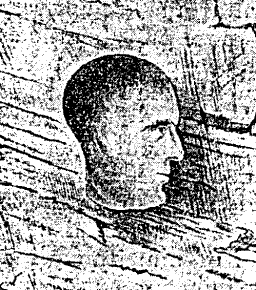 |
Science Frontiers ONLINE No. 121: Jan-Feb 1999 |
|
|
Problems Of Aboriginal Art In Australia
In SF#117, we reproduced some Australian rock art featuring sylph-like, flowing human figures quite unlike today's aborigines. In our more recent library searches, we have come across an old article that provides additional examples of the socalled Bradshaw paintings -- more of those graceful human forms with long, billowing tresses. Very out-ofplace in today's Outback.
The same article adds an even more puzzling human representation to the burgeoning file of mysterious Australian art. It is a carving found in a cave of northwestern Australia. Here is the text accompanying the sketch.
"Another cave introduced a fresh problem. Fronting it, high up on the vertical face of a cliff, and unreachable without mechanical aid, had been carved out of the solid stone a human head in profile, which I show. It was 2 feet long and 16 inches across, and 1�-inch thick; and I leave my hearers to say whether it is not a striking and distinguished face. It is absolutely different from the heads of modern Aborigines. The worn edges of the cameo, where it joined the rock-surface, seemed to mark a long interval since it was carved; the difficulty of carving it where it stood must have been immense -- unless, indeed, the rock face had been near the ground at the time, and the ground had worn away since -- which, again, would probably imply antiquity.
"What a problem this Caucasian face presents! Is it that of some stranger from Europe long ago -- perhaps before the Portugese or Spanish visitors of the sixteenth and seventeenth centuries? In all probability European ships traversed the Pacific before the days of Balboa; for Greek columns are found in an island of the South Seas; and the prevalence of small-pox among the Australians when we first settled there is said -- with what truth I must leave pathologists to decide -- to postulate previous residence of Europeans amongst them."
(Thornton, S.; "Problems of Aboriginal Art in Australia," Victoria Institute, Journal of the Transactions, 30:205, 1897.)
